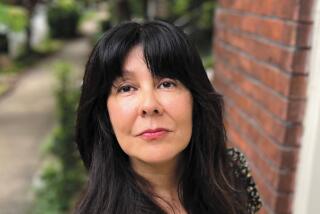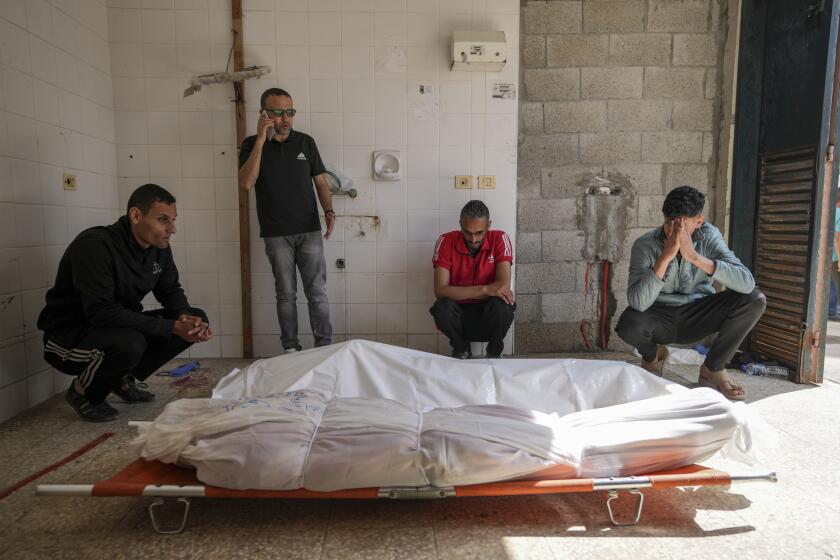In Australia’s outback, troubled youths find help in old traditions
The elders of the Warlpiri Aboriginal tribe in outback Australia look at a person’s footprints: A good person, it’s believed, leaves good prints in the red dust.
Four years ago, Sebastian Watson’s footsteps were said to have turned bad for a time: He had a brush with the law and was charged with assault. The elders of the remote Yuendumu community sent him off into the bush to Mt. Theo, a retreat where Peggy Brown and her husband cared for him along with other troubled young people.
Brown, her face as wrinkled as the stony hills that rise from the surrounding desert, knew how to make Watson healthy on the outside with good food and clean living. She also worked to make him strong on the inside, immersing him in the ancient Warlpiri culture, with its deep connections to land, kin and ceremony.
After his arrival, Watson was asked to fetch wood for a campfire. He walked into the bush and tore a branch from a dry tree.
When the flames crackled up, something happened: “I felt the spirit of the tree, and the spirit of the fire,” he recalled. “I believe I was being healed spiritually because it’s a healing place.”
Around the campfire, Brown instructed the troubled youngsters about their Warlpiri identity. She talked about things that kill the culture: alcohol, marijuana, violence.
When he lay down to sleep, Watson said, “the spirit of the land met my spirit inside me. The spirit talked and talked. I could feel it. My spirit listened. I could feel the tension going out of my body, when I was lying there. The spirit was saying, ‘You are gifted. You’ve got to use these gifts in a good way. Don’t ruin these gifts with sorrow.’”
Watson now works as a mentor and counselor for the Warlpiri Youth Development Aboriginal Corp., or WYDAC, helping other troubled young people from his community.
The group’s work continues amid lingering violence and high rates of youth incarceration and attempted suicide.
It began two decades ago in Yuendumu, when the problem of youths sniffing gasoline swept the outback. Elders became afraid a generation of children would be lost, and with them centuries of oral history and tradition, if there was nobody to pass the knowledge to.
Reciting their story, white-haired elders and other community leaders sit in a semicircle, scattering the anecdotes like random pebbles onto the ground. Their musical Warlpiri language sounds like a bubbling creek, but there’s no order to their tale. Their chatter swells, several speaking at once, beginning in English, breaking into Warlpiri, and back.
When the gas sniffing was introduced by two boys from another community, the elders say, they started nightly patrols, carrying torches and sticks, to drag youngsters from their shadowy dens and take them home. But the children, some as young as 11, went back to sniffing the next day.
Gas caps from cars went missing, thrown into the bush as boys siphoned most of the poisonous substance from a tank. The addiction led to house break-ins and fights, turning many deranged and apathetic.
Eddie Robertson and his wife, Lottie, describe the torment when two of their sons started sniffing.
“I used to go around looking for them. They were always in dark houses, where the old houses were, out near the airstrip.” Lottie Robertson says. “I’d look at [one of them] and I’d say, ‘I want you to come home,’ and he’d look at me and laugh at me. It would make me cry.
“We were worried and angry. We wanted to stop them and bring them home. We didn’t know we were hurting them too. We wanted to stop it, but it didn’t work.”
Desperate, the elders called a community meeting that came up with the Mt. Theo retreat plan. Sending them far away into the bush was part punishment but also meant to heal and to teach the Warlpiri culture. Mt. Theo was chosen because it was believed to have ancient healing qualities.
“A project like that, when you try to get people back on track, it’s just out of love and care for them,” Lottie Robertson says. There was no government funding, so members of the community kicked in money to pay the gasoline to take people to out Mt. Theo, pay for food and care for them.
The community declared itself “dry,” meaning no alcohol could be consumed there, although “grog running” (alcohol smuggling) went on, feeding more violence. Several years ago, the fights threatened to tear the community apart, as a dispute between clans spun out of control. The community still remains fragile.
Brown continues to work in the bush healing troubled youths, offering rewards for those who come back: sports and leisure activities, trips into the bush to learn more about Warlpiri culture, youth mentorships and job training. As a safety net, there’s emergency counseling for young people in crisis.
Watson developed an anti-violence campaign for the local sports league.
He and another WYDAC counselor, Geraldine Dixon — his mother-in-law — get calls day and night, in cases of family crisis: a teen behaving violently, teenage mothers having trouble coping, a young person considering suicide.
“I’ve had young people come through that at night,” Watson says, referring to suicidal cases. “Sometimes I tell them to come sleep at my place. Sometimes I encourage them to talk to the elders, and we all come together to talk.”
Dixon speaks in a voice so soft that at times it fades into the sweltering afternoon. She uses the same calm voice when faced with a crisis. “You say, ‘What is the problem? Why are you angry?’ It’s got to be in a calm way, talking to someone who’s at high risk. I stay until the person settles down.”
When rains come to central Australia’s red outback, the bush turns a soft gray-green, and the honey ants burrow up from deep down toward the surface seeking moisture.
Honey ants, with swollen grape-like tails filled with nectar, are at the center of Warlpiri “dreaming” — the tribal stories that explain creation, life and existence. After the rains, Dixon, who knows the traditions of hunting and gathering, goes into the bush with a group of troubled girls. The bush trips pull them back to life.
Dixon shows them where to dig down to find the honey ants, the sweetest morsel that can be found in the harsh outback. They pluck the ants from their nests, sucking the ants’ swollen yellow tails, feeling the joyful burst of sweet nectar on their tongues.
More to Read
Start your day right
Sign up for Essential California for news, features and recommendations from the L.A. Times and beyond in your inbox six days a week.
You may occasionally receive promotional content from the Los Angeles Times.






